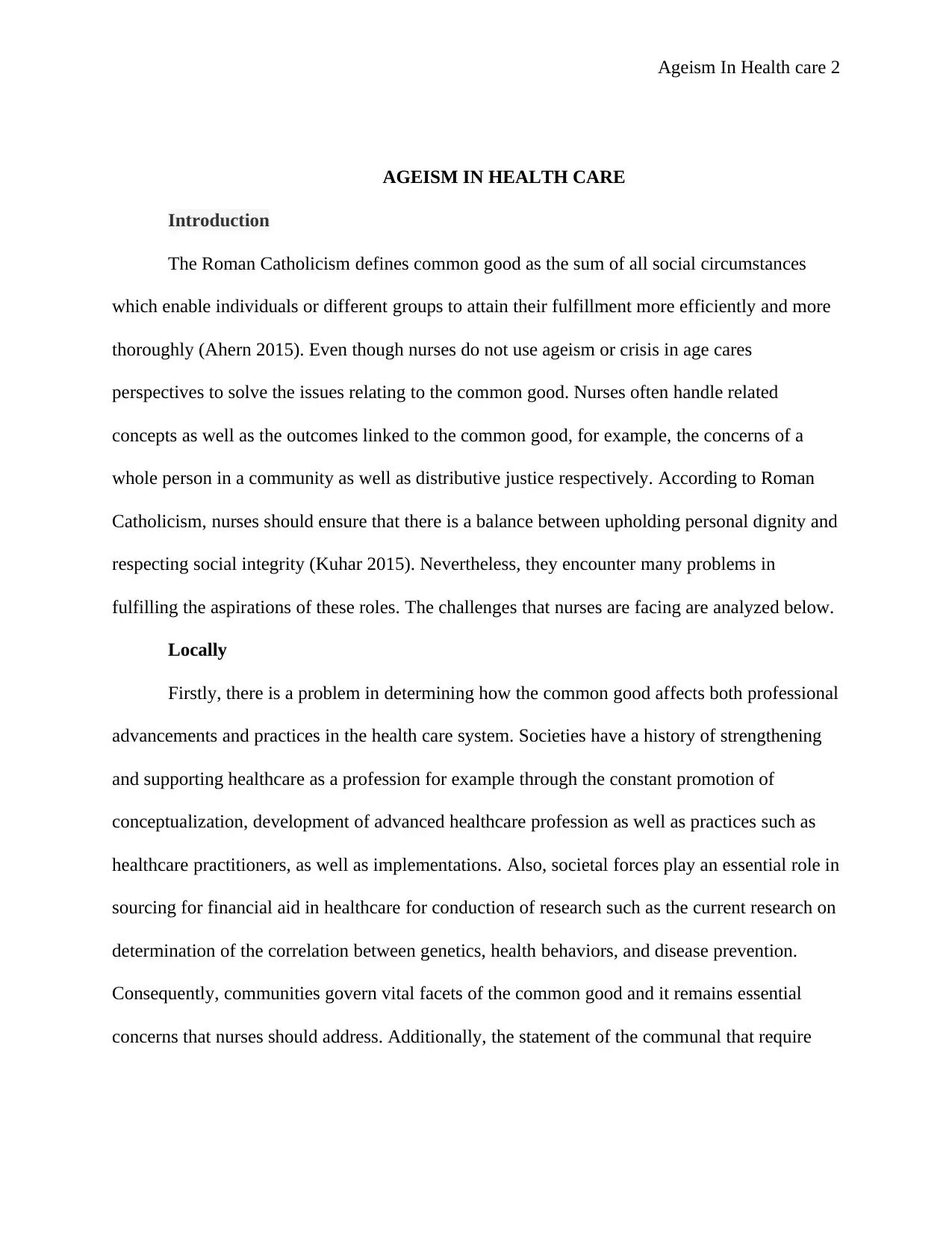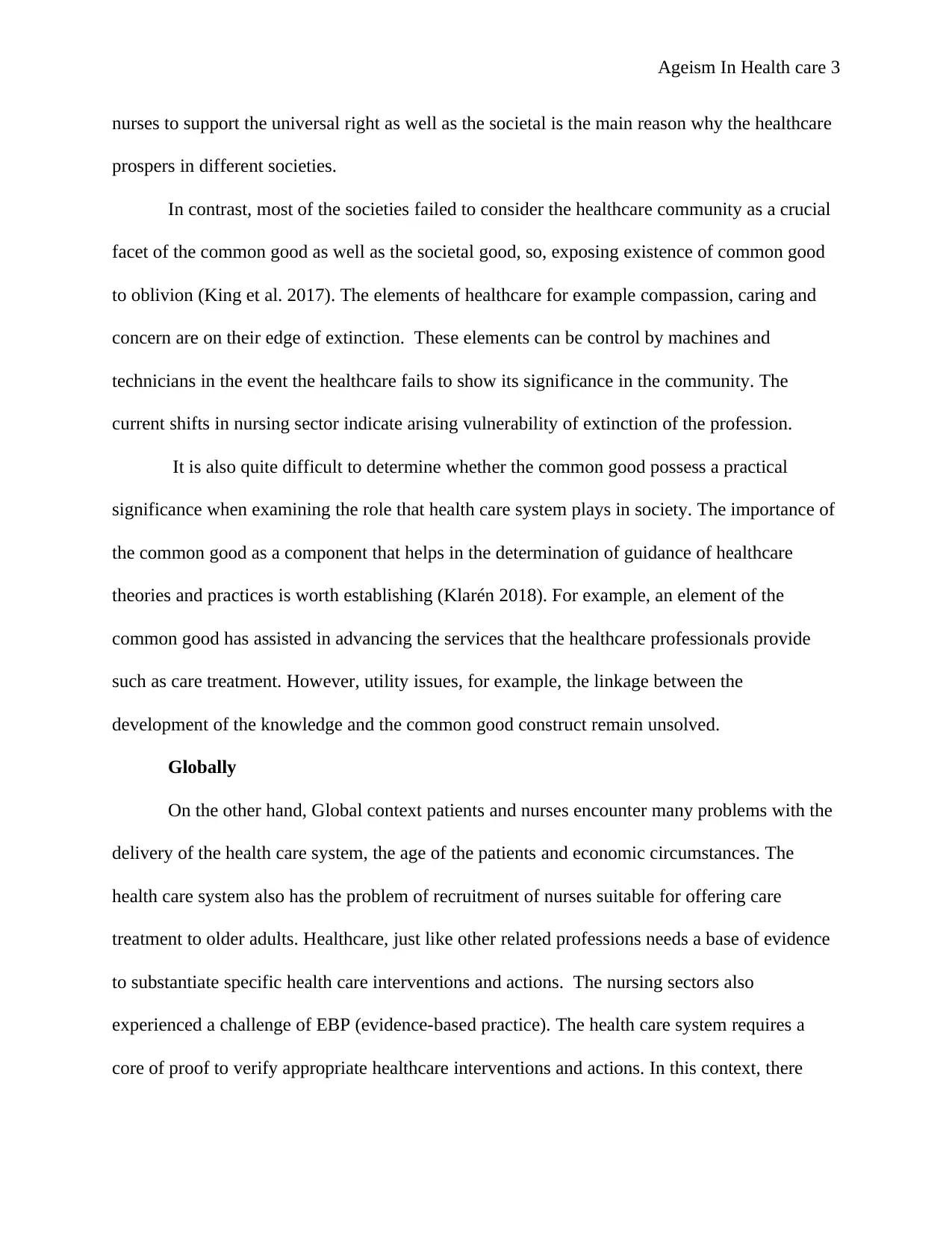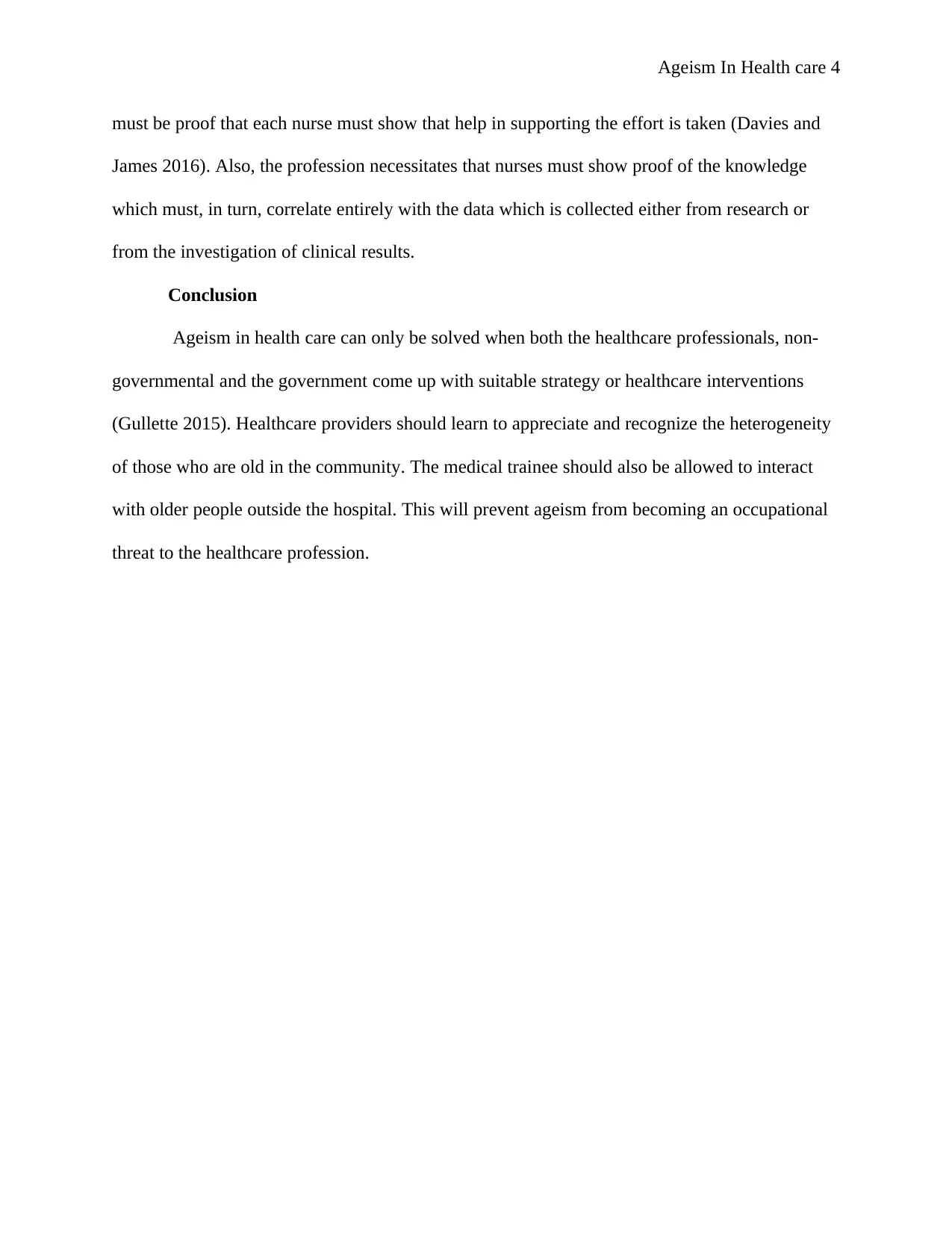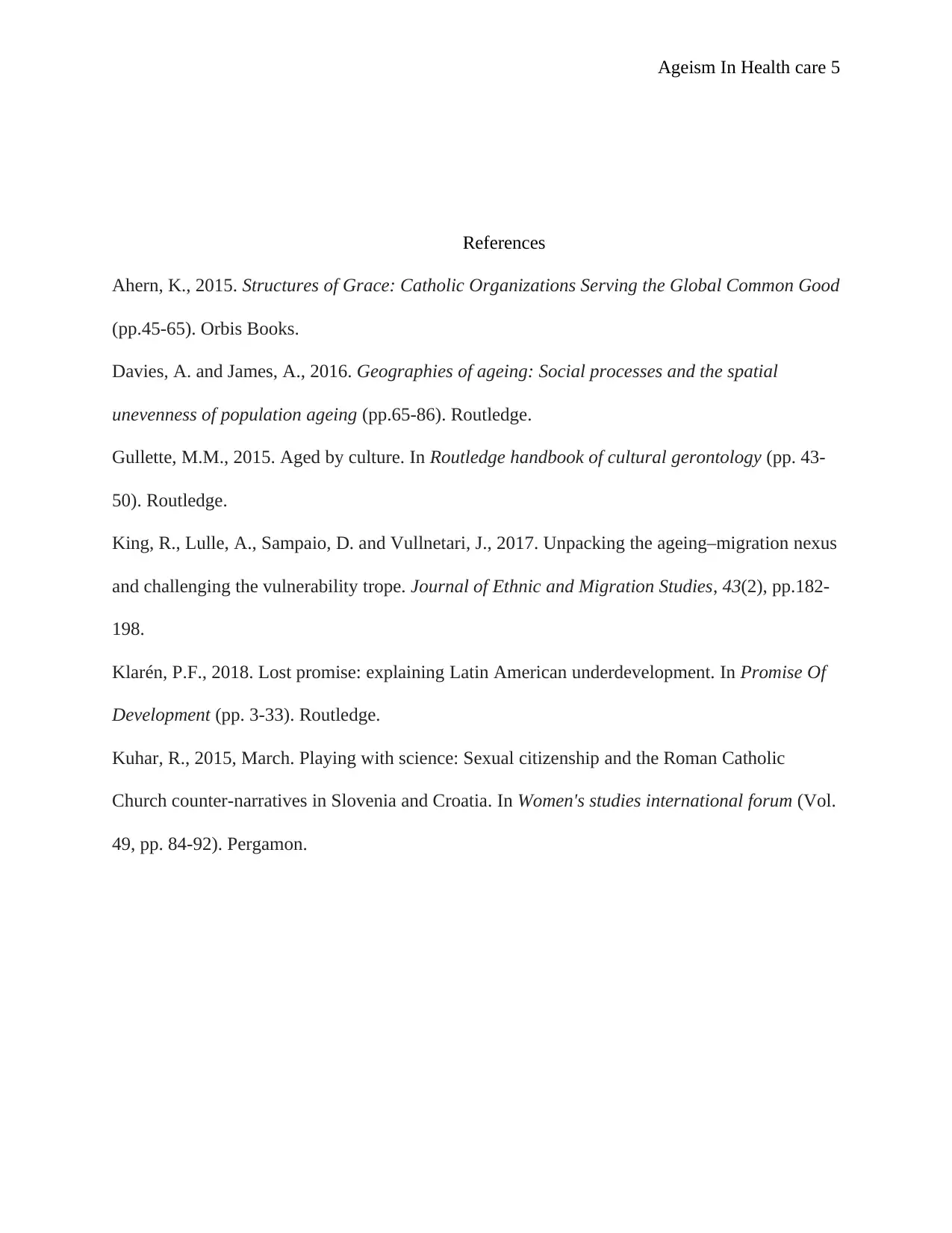Ageism in Healthcare: Challenges to Common Good in Healthcare
VerifiedAdded on 2023/01/13
|5
|992
|53
Essay
AI Summary
This essay delves into the pervasive issue of ageism within the healthcare system, analyzing its impact on the common good from both local and global perspectives. The introduction defines the common good through the lens of Roman Catholicism, highlighting the importance of balancing personal dignity and social integrity. The essay then explores specific challenges, including difficulties in integrating the common good into professional practices, societal failures to recognize healthcare's importance, and the vulnerability of healthcare elements like compassion. Globally, the essay examines the challenges patients and nurses face, including recruitment issues and the need for evidence-based practices. The conclusion underscores the need for collaborative strategies involving healthcare professionals, non-governmental organizations, and governments to combat ageism, emphasizing the importance of recognizing the heterogeneity of older adults and providing medical trainees with opportunities to interact with them.

Ageism In Health care 1
AGEISM IN HEALTH CARE
By (Student’s Name)
Professor’s Name
College
Course
Date
AGEISM IN HEALTH CARE
By (Student’s Name)
Professor’s Name
College
Course
Date
Paraphrase This Document
Need a fresh take? Get an instant paraphrase of this document with our AI Paraphraser

Ageism In Health care 2
AGEISM IN HEALTH CARE
Introduction
The Roman Catholicism defines common good as the sum of all social circumstances
which enable individuals or different groups to attain their fulfillment more efficiently and more
thoroughly (Ahern 2015). Even though nurses do not use ageism or crisis in age cares
perspectives to solve the issues relating to the common good. Nurses often handle related
concepts as well as the outcomes linked to the common good, for example, the concerns of a
whole person in a community as well as distributive justice respectively. According to Roman
Catholicism, nurses should ensure that there is a balance between upholding personal dignity and
respecting social integrity (Kuhar 2015). Nevertheless, they encounter many problems in
fulfilling the aspirations of these roles. The challenges that nurses are facing are analyzed below.
Locally
Firstly, there is a problem in determining how the common good affects both professional
advancements and practices in the health care system. Societies have a history of strengthening
and supporting healthcare as a profession for example through the constant promotion of
conceptualization, development of advanced healthcare profession as well as practices such as
healthcare practitioners, as well as implementations. Also, societal forces play an essential role in
sourcing for financial aid in healthcare for conduction of research such as the current research on
determination of the correlation between genetics, health behaviors, and disease prevention.
Consequently, communities govern vital facets of the common good and it remains essential
concerns that nurses should address. Additionally, the statement of the communal that require
AGEISM IN HEALTH CARE
Introduction
The Roman Catholicism defines common good as the sum of all social circumstances
which enable individuals or different groups to attain their fulfillment more efficiently and more
thoroughly (Ahern 2015). Even though nurses do not use ageism or crisis in age cares
perspectives to solve the issues relating to the common good. Nurses often handle related
concepts as well as the outcomes linked to the common good, for example, the concerns of a
whole person in a community as well as distributive justice respectively. According to Roman
Catholicism, nurses should ensure that there is a balance between upholding personal dignity and
respecting social integrity (Kuhar 2015). Nevertheless, they encounter many problems in
fulfilling the aspirations of these roles. The challenges that nurses are facing are analyzed below.
Locally
Firstly, there is a problem in determining how the common good affects both professional
advancements and practices in the health care system. Societies have a history of strengthening
and supporting healthcare as a profession for example through the constant promotion of
conceptualization, development of advanced healthcare profession as well as practices such as
healthcare practitioners, as well as implementations. Also, societal forces play an essential role in
sourcing for financial aid in healthcare for conduction of research such as the current research on
determination of the correlation between genetics, health behaviors, and disease prevention.
Consequently, communities govern vital facets of the common good and it remains essential
concerns that nurses should address. Additionally, the statement of the communal that require

Ageism In Health care 3
nurses to support the universal right as well as the societal is the main reason why the healthcare
prospers in different societies.
In contrast, most of the societies failed to consider the healthcare community as a crucial
facet of the common good as well as the societal good, so, exposing existence of common good
to oblivion (King et al. 2017). The elements of healthcare for example compassion, caring and
concern are on their edge of extinction. These elements can be control by machines and
technicians in the event the healthcare fails to show its significance in the community. The
current shifts in nursing sector indicate arising vulnerability of extinction of the profession.
It is also quite difficult to determine whether the common good possess a practical
significance when examining the role that health care system plays in society. The importance of
the common good as a component that helps in the determination of guidance of healthcare
theories and practices is worth establishing (Klarén 2018). For example, an element of the
common good has assisted in advancing the services that the healthcare professionals provide
such as care treatment. However, utility issues, for example, the linkage between the
development of the knowledge and the common good construct remain unsolved.
Globally
On the other hand, Global context patients and nurses encounter many problems with the
delivery of the health care system, the age of the patients and economic circumstances. The
health care system also has the problem of recruitment of nurses suitable for offering care
treatment to older adults. Healthcare, just like other related professions needs a base of evidence
to substantiate specific health care interventions and actions. The nursing sectors also
experienced a challenge of EBP (evidence-based practice). The health care system requires a
core of proof to verify appropriate healthcare interventions and actions. In this context, there
nurses to support the universal right as well as the societal is the main reason why the healthcare
prospers in different societies.
In contrast, most of the societies failed to consider the healthcare community as a crucial
facet of the common good as well as the societal good, so, exposing existence of common good
to oblivion (King et al. 2017). The elements of healthcare for example compassion, caring and
concern are on their edge of extinction. These elements can be control by machines and
technicians in the event the healthcare fails to show its significance in the community. The
current shifts in nursing sector indicate arising vulnerability of extinction of the profession.
It is also quite difficult to determine whether the common good possess a practical
significance when examining the role that health care system plays in society. The importance of
the common good as a component that helps in the determination of guidance of healthcare
theories and practices is worth establishing (Klarén 2018). For example, an element of the
common good has assisted in advancing the services that the healthcare professionals provide
such as care treatment. However, utility issues, for example, the linkage between the
development of the knowledge and the common good construct remain unsolved.
Globally
On the other hand, Global context patients and nurses encounter many problems with the
delivery of the health care system, the age of the patients and economic circumstances. The
health care system also has the problem of recruitment of nurses suitable for offering care
treatment to older adults. Healthcare, just like other related professions needs a base of evidence
to substantiate specific health care interventions and actions. The nursing sectors also
experienced a challenge of EBP (evidence-based practice). The health care system requires a
core of proof to verify appropriate healthcare interventions and actions. In this context, there
⊘ This is a preview!⊘
Do you want full access?
Subscribe today to unlock all pages.

Trusted by 1+ million students worldwide

Ageism In Health care 4
must be proof that each nurse must show that help in supporting the effort is taken (Davies and
James 2016). Also, the profession necessitates that nurses must show proof of the knowledge
which must, in turn, correlate entirely with the data which is collected either from research or
from the investigation of clinical results.
Conclusion
Ageism in health care can only be solved when both the healthcare professionals, non-
governmental and the government come up with suitable strategy or healthcare interventions
(Gullette 2015). Healthcare providers should learn to appreciate and recognize the heterogeneity
of those who are old in the community. The medical trainee should also be allowed to interact
with older people outside the hospital. This will prevent ageism from becoming an occupational
threat to the healthcare profession.
must be proof that each nurse must show that help in supporting the effort is taken (Davies and
James 2016). Also, the profession necessitates that nurses must show proof of the knowledge
which must, in turn, correlate entirely with the data which is collected either from research or
from the investigation of clinical results.
Conclusion
Ageism in health care can only be solved when both the healthcare professionals, non-
governmental and the government come up with suitable strategy or healthcare interventions
(Gullette 2015). Healthcare providers should learn to appreciate and recognize the heterogeneity
of those who are old in the community. The medical trainee should also be allowed to interact
with older people outside the hospital. This will prevent ageism from becoming an occupational
threat to the healthcare profession.
Paraphrase This Document
Need a fresh take? Get an instant paraphrase of this document with our AI Paraphraser

Ageism In Health care 5
References
Ahern, K., 2015. Structures of Grace: Catholic Organizations Serving the Global Common Good
(pp.45-65). Orbis Books.
Davies, A. and James, A., 2016. Geographies of ageing: Social processes and the spatial
unevenness of population ageing (pp.65-86). Routledge.
Gullette, M.M., 2015. Aged by culture. In Routledge handbook of cultural gerontology (pp. 43-
50). Routledge.
King, R., Lulle, A., Sampaio, D. and Vullnetari, J., 2017. Unpacking the ageing–migration nexus
and challenging the vulnerability trope. Journal of Ethnic and Migration Studies, 43(2), pp.182-
198.
Klarén, P.F., 2018. Lost promise: explaining Latin American underdevelopment. In Promise Of
Development (pp. 3-33). Routledge.
Kuhar, R., 2015, March. Playing with science: Sexual citizenship and the Roman Catholic
Church counter-narratives in Slovenia and Croatia. In Women's studies international forum (Vol.
49, pp. 84-92). Pergamon.
References
Ahern, K., 2015. Structures of Grace: Catholic Organizations Serving the Global Common Good
(pp.45-65). Orbis Books.
Davies, A. and James, A., 2016. Geographies of ageing: Social processes and the spatial
unevenness of population ageing (pp.65-86). Routledge.
Gullette, M.M., 2015. Aged by culture. In Routledge handbook of cultural gerontology (pp. 43-
50). Routledge.
King, R., Lulle, A., Sampaio, D. and Vullnetari, J., 2017. Unpacking the ageing–migration nexus
and challenging the vulnerability trope. Journal of Ethnic and Migration Studies, 43(2), pp.182-
198.
Klarén, P.F., 2018. Lost promise: explaining Latin American underdevelopment. In Promise Of
Development (pp. 3-33). Routledge.
Kuhar, R., 2015, March. Playing with science: Sexual citizenship and the Roman Catholic
Church counter-narratives in Slovenia and Croatia. In Women's studies international forum (Vol.
49, pp. 84-92). Pergamon.
1 out of 5
Related Documents
Your All-in-One AI-Powered Toolkit for Academic Success.
+13062052269
info@desklib.com
Available 24*7 on WhatsApp / Email
![[object Object]](/_next/static/media/star-bottom.7253800d.svg)
Unlock your academic potential
Copyright © 2020–2025 A2Z Services. All Rights Reserved. Developed and managed by ZUCOL.





